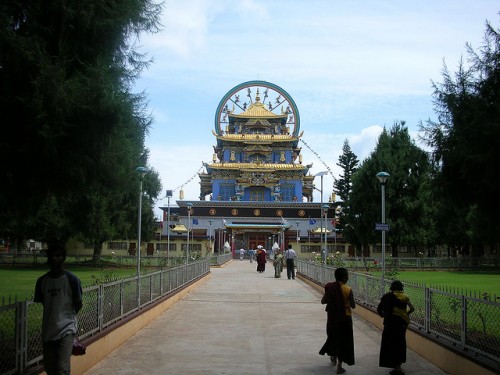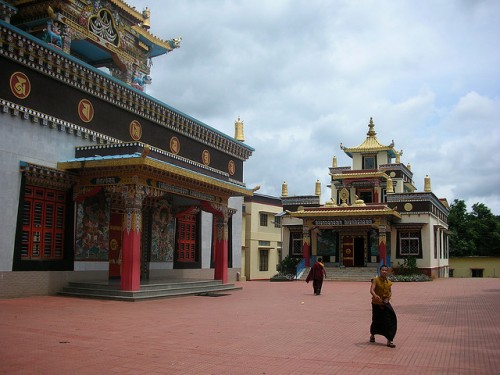Bylakuppe: A visit to this Tibetan Town in Karnataka
Being the capital of the Tibetan government in exile, Dharamsala in Himachal Pradesh has been the destination of many travelers in search of peace, tranquility and spiritual guidance. A lesser
Being the capital of the Tibetan government in exile, Dharamsala in Himachal Pradesh has been the destination of many travelers in search of peace, tranquility and spiritual guidance.
A lesser known Tibetan town in India is Bylakuppe, situated 90 kilometers from Mysore on SH 88. Bylakuppe comprises of two Tibetan refugee settlements that were setup in 1961 and 1969 respectively and has now grown into a full-fledged town housing the largest Tibetan population outside of Dharamsala in India.
Bylakuppe has been one of my travel destinations of choice due to its proximity to Mysore. It is easily accessible by bus and a journey of two hours followed by a pleasant and picturesque walk for half an hour off SH 88 will take you into the heart of town.
The walk from where the bus drops you off on the state highway to the settlement camp is beautiful. The gradual change in scenery and the feeling of being transported to another country with every step one takes towards where the monasteries are located adds to its mystique and charm. Long rows of multi-coloured Tibetan prayer flags tied to electricity poles flutter gently in the wind. Signboards have the Tibetan script in addition to having words in English and Kannada. The houses look different with their distinctive tiled roofs and as one walks along the meandering road, one begins to see an increasing number of Tibetan people in addition to the auto rickshaw drivers that ferry people from the highway into the camp area. It feels pleasantly like having walked into a place that is peaceful and tranquil, almost hill-station like save for the absence of hills in the area.
The monastery buildings appear on the horizon, one by one and their distinctive shapes are remarkably different from all other buildings on the road between Mysore and Madikeri.
The most famous monastery in the region is Namdroling, located in camp 4 of the settlement. Being the most popular, it plays host to many tourists from all over that stop here on their way to the Nilgiris or on their way back from there. The entrance to the monastery faces a shiny, concrete shopping complex which, quite frankly is an eyesore on the landscape.


However, it is easy to get inured to the presence of this freshly painted concrete monstrosity as one turns 180 degrees and stares in awe at the golden temple and begins to turn the prayer wheels on the outer perimeter of the monastery before entering the temple complex proper.
Buddhists believe that turning prayer wheels that contain prayer scrolls in a clockwise direction is equivalent to actually saying the prayer. While offering short-cuts towards the ever so elusive albeit vastly appealing ideal of Nirvana, it also ensures more inclusivity. The uneducated poor, the soul-searching tourist, the monk in the maroon robe and the incidental itinerant, all get an equal share of Karmic brownie points to be redeemed later for spinning the wheels. There are many wheels to be spun and a first time visitor who doesn’t exercise enough is sure to develop a slight pain in his / her right shoulder by the time all the wheels are spun!

The complex houses, among other things the temple, a library and rooms to accommodate all the monks studying there. On a good day, it is possible to not encounter too many tourists and get a chance to sit inside the temple, close your eyes and meditate as sparrows chirp and flutter inside, while the delicate smell of incense hangs in the air. On some days, you can hear the steady hum of chants as many monks pray in long drawn out powerful choruses.
It was initially possible to go close to the tall statues within the temple, but a recent change has cordoned off most parts of the temple, significantly reduce the accessible area there.
A long, leisurely visit to the Namdroling monastery would take up almost half a day, though Bylakuppe has more to offer in terms of places to see. Camp 1, located two kilometers away houses the less popular Sera Mey and Sera Jay monasteries. To get there, one can take an auto rickshaw or walk for a little over twenty minutes through alleyways having traditional Tibetan houses, to get a sense of what a hotter, more tropical version of Lhasa would possibly look like. The houses of the locals, with the Tibetan script and the multi-coloured flags hanging by the doorway are as interesting to look at as the majestic monastery buildings themselves.

At the less crowded Sera monasteries, it is sometimes possible to sit outside on the steps and talk in broken Hindi and English (and sometimes Kannada) with monks who are happy to answer your curious questions about their way of life. They are as curious in return and the slightest attempt at humour is met with genuine chuckles and smiles that tell you that you’re welcome to spend some time there.
The food here comprises mainly of a variety of thukpas (Tibetan flat noodle soup) served in various flavours, with dim-sums being available occasionally in some shops. Visitors wary of experimenting with the different taste can always find food on the state highway or in the tourist complex where south Indian staple fare is abundantly available.
If adventure and thrill is what you seek, Bylakuppe might not be the best place for you to visit. If what you desire is a quiet, peaceful time with the right blend of spirituality, nature and some picturesque landscape, get on that bus and go there already!
This story made me
-
97
-
121
-
89
-
167











